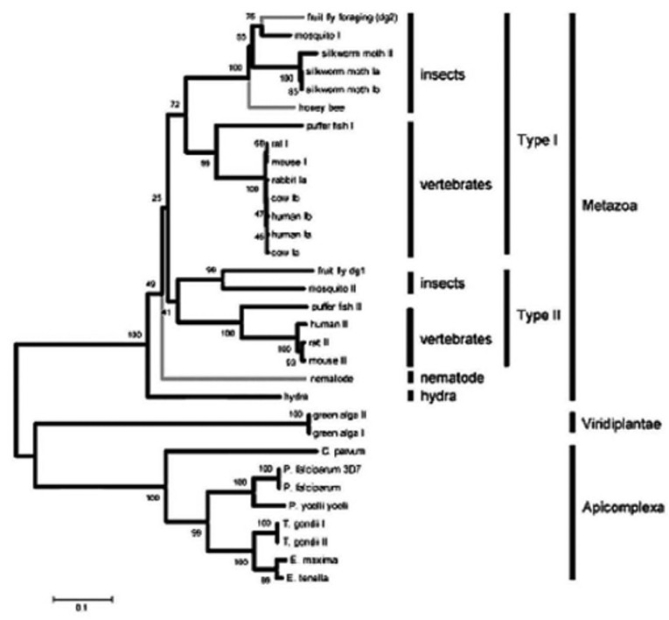Use the following information to answer the following question(s) .
The following are an abstract and figure from a paper that explores the evolutionary relationship between a protein kinase and behavior (M. Fitzpatrick and M. Sokolowski. 2004. In search of food: Exploring the evolutionary link between cGMP-dependent protein kinase (PKG) and behavior. Integrative and Comparative Biology 44:28-36) .
Abstract:
Despite an immense amount of variation in organisms throughout the animal kingdom, many of their genes show substantial conservation in DNA sequence and protein function. Here we explore the potential for a conserved evolutionary relationship between genes and their behavioral phenotypes. We investigate the evolutionary history of cGMP-dependent protein kinase (PKG) and its possible conserved function in food-related behaviors. First identified for its role in the foraging behavior of fruit flies, the PKG encoded by the foraging gene had since been associated with the maturation of behavior (from nurse to forager) in honey bees and the roaming and dwelling food-related locomotion in nematodes. These parallels encouraged us to construct protein phylogenies using 32 PKG sequences that include 19 species. Our analyses suggest five possible evolutionary histories that can explain the apparent conserved link between PKG and behavior in fruit flies, honey bees, and nematodes. Three of these raise the hypothesis that PKG influences the food-related behaviors of a wide variety of animals including vertebrates. Moreover it appears that the PKG gene was duplicated some time between the evolution of nematodes and a common ancestor of vertebrates and insects whereby current evidence suggests only the for-like PKG might be associated with food-related behavior.  These are neighbor joining trees that depict the evolutionary relationships of 32 PKG kinase domain and C-terminal amino acid sequences spanning 19 species of protozoans and metazoans. Values at the nodes represent the results of 5000 bootstrap replications. Lineages with known behavioral links with PKG are indicated by gray branches.
These are neighbor joining trees that depict the evolutionary relationships of 32 PKG kinase domain and C-terminal amino acid sequences spanning 19 species of protozoans and metazoans. Values at the nodes represent the results of 5000 bootstrap replications. Lineages with known behavioral links with PKG are indicated by gray branches.
-Using the figure and the accompanying paragraph, and knowing that the PKG encoded by the foraging gene has recently been associated with the maturation of out-of-nest behavior in honeybees, what would be a logical explanation for this relationship? As animals mature, they ________.
A) require more food; therefore, PKG levels must increase.
B) are more likely to forage; therefore, PKG levels must increase.
C) respond to pheromones from the queen, which increases PKG levels.
D) are able to fly, an activity that is connected to the increase in PKG levels.
Correct Answer:
Verified
Q1: Which of the following is required for
Q2: Listed below are several examples of types
Q6: The proximate causes of behavior are interactions
Q7: Which of the following might affect the
Q8: Why would you expect some white-fronted bee-eaters
Q10: The accompanying graph shows data collected to
Q11: A lizard's bobbing dewlap (a colorful flap
Q12: In testing a hypothesis that "territorial defense
Q59: Which of the following statements about evolution
Q62: During a field trip, an instructor touched
Unlock this Answer For Free Now!
View this answer and more for free by performing one of the following actions

Scan the QR code to install the App and get 2 free unlocks

Unlock quizzes for free by uploading documents